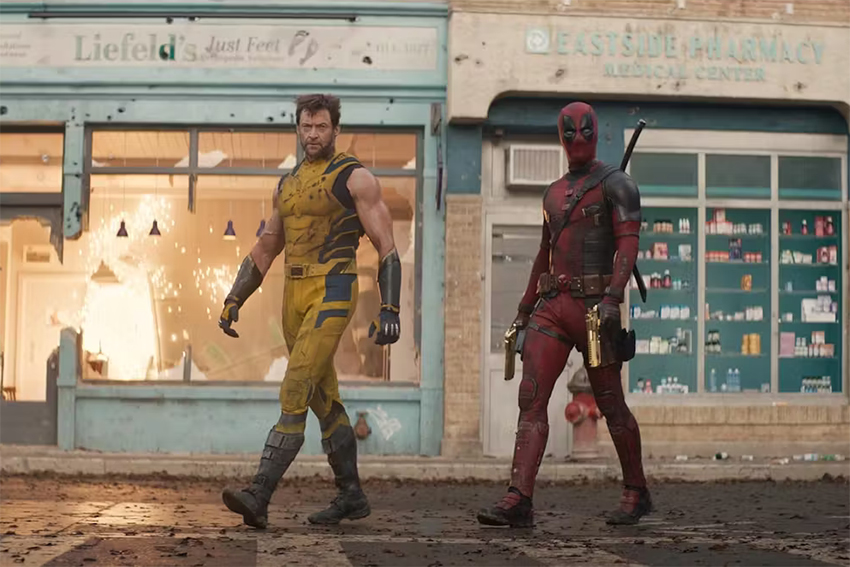Is Deadpool & Wolverine the hit needed?

![]() This article is republished from The Conversation under a Creative Commons license and written by Auckland University of Technology's Professor Lorna Piatti-Farnell. Read the original article.
This article is republished from The Conversation under a Creative Commons license and written by Auckland University of Technology's Professor Lorna Piatti-Farnell. Read the original article.
Last week, the Marvel Cinematic Universe’s (MCU) latest offering, Deadpool & Wolverine, opened in theatres worldwide. The film brings two highly popular characters, played by Ryan Reynolds and Hugh Jackman, back to the silver screen – raking in about US$440 million (A$672 million) from its global opening.
The film certainly doesn’t shy away from fan service, with much of the material seemingly added just to please existing fans. The plot is filled with in-jokes, including a variety of meta-references to the alleged off-screen feud between Reynolds and Jackman.
In fact, I’d say the film appears to be solely intended for a specific segment of Marvel’s existing fanbase, with very few attempts at making the story palatable to a global audience.
This is a noteworthy choice for a standalone Marvel film – especially at a time when superhero films have lost some of their lustre. Marvel’s previous release, The Marvels (2023), ended its box-office run as the lowest-grossing film in the MCU’s history, making about US$197 million globally.
It’ll be intriguing to see the effect of Deadpool & Wolverine on the declining popularity of the MCU. Will it end up being the hero Marvel needs? Or will our collective “superhero fatigue” ultimately keep it from reaching its potential?
Marvel’s formula comes undone
After the global peak of Avengers: Endgame (2019), things haven’t quite been the same in the Marvel corner. While the studios have forcefully continued to produce several films and series, the excitement that characterised the release of Marvel movies pre-Endgame seems to have virtually disappeared.
Marvel Studios’ recent failure to replicate its longstanding success can probably be attributed to a few factors. First and foremost is that Marvel seems to have lost the coherent structure that supported its pre-2019 superhero movies, beginning in 2008 with the release of Iron Man. Films from this era focused on developing stories and superhero characters belonging to the now much-beloved Avengers group.
Although there were several other films focused on the exploits of individual characters – such as Captain America: The First Avenger (2011), Thor (2011) and Black Panther (2018) – all of these narrative offshoots regularly converged back to the central Avengers storyline, which itself was advanced through films such as The Avengers (2012), Age of Ultron (2015), Infinity War (2018) and, finally, Endgame.
This winning formula ensured box-office success for Marvel. In Endgame, however, the principal storyline that had driven so much of the MCU until then overtly came to an end.
The film not only tightened the narrative strings of previous stories, it also saw the death of key characters including Tony Stark as Iron Man (Robert Downey Jr) and Natasha Romanov as Black Widow (Scarlett Johansson) – and the “loss” of Steve Rogers as Captain America. Fans worldwide felt the film had lived up to its name, marking the end of the MCU as they knew it.
IMDB
Marvel has tried to keep its momentum going post-Endgame, in what has become known as “phase 4” of the MCU. In recent years, the studios have produced a growing number of series such as The Falcon and the Winter Soldier (2021), WandaVision (2021) and Loki (2021), to name a few.
Disney’s takeover
Central to the boom in production has been Marvel’s merger with Disney. The acquisition of Marvel Entertainment by Disney actually happened in 2009. However, it wasn’t until after Endgame that the relationship openly came to fruition, when Disney’s new streaming venues truly came to play a part.
After 2019, Marvel’s series have been primarily streamed on Disney+, consolidating the studios’ place as part of Disney. The decision to adapt to the online Disney model, however, may have contributed to the decline in Marvel’s success. In following the production-heavy model that suits platforms such as Disney+, Marvel may have been spread too thin – leaving characters and storylines half-developed and gaining a series of flops.
Trying too hard?
Another result of the overproduction of superhero films and media is what has become known as “superhero fatigue”, wherein there are just too many superhero stories around (often of questionable quality) for even loyal fans to appreciate them.
Deadpool & Wolverine therefore comes in the wake of a very difficult time for Marvel. The film definitely relies heavily on the iconicity of the two titular superheroes and in particular on the introduction of Wolverine into the MCU canon. Whether this gamble has been successful remains to be seen.
Although box office returns have been high since opening night, reviews have been mixed. Some have appreciated the meta-humour, where the specific jokes give the film a kind of “self-awareness”. But others have been put off by the unbelievable plot which often leans into pastiche, even as it tries to echo the visual spectacle that was characteristic of the Avengers franchise.
In a way, Deadpool & Wolverine feels like something of a filler film, strategically placed to recapture fans’ attention through what is essentially a parody of the superhero genre.
The film was also released alongside Marvel’s announcement of the upcoming Avengers: Doomsday, expected in 2026–27. This will be directed once again by the Russo brothers and will (somewhat unexpectedly) bring back Downey Jr in the new role of Doctor Doom.
It’s hard to predict whether this new direction will revive the MCU. For the time being, Deadpool & Wolverine – while generally enjoyable – does little to ease the pain of Marvel fatigue.